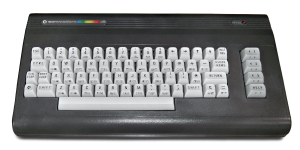This post may not be quite about what you think it’s about.
In my “Reassessing the Atari 5200” post below, I talked about how shocked I was to learn that Atari had developed the internals for that console five years before they had released it. It appeared as though Atari sat on this technology for half a decade while their competitors released better consoles and took away market share, all while the over-saturation that led up to the 1983 video game crash was building.
Well, that’s not an accurate portrayal of what was really going on. I never owned an Atari 8-bit computer, but I do remember them from my childhood. And I consistently forget that they had been around for as long as they did. The Atari 400 and Atari 800 were first released in 1979, so that’s only two years of sitting on technology.
And it turns out that the technology inside these computers were originally designed to be the next generation game console to replace the Atari 2600. Atari only made them into computers when other companies like Apple and Commodore were having success bringing home computers to the market.
The Atari computers had their own rabid fan base and large libraries of games, but I’ve never gotten into many of them except as ports that were made for my computer the Commodore 64. M.U.L.E. comes to mind as one of these. Oh, how I loved that game.
But I’d like to get back on topic by showing you all a picture of the original Atari 800 computer:
You sure can tell that it’s from the 70s. And that’s why I’m talking about it, because I want one. But I don’t want one because of what’s inside, no. I want one because of the case. I’m sorry Atari 800, I only want you because of the way you look. I’m so shallow!
This would be a great case to build a modern computer into. Lord knows there’s room to spare. There are barely enough keys, and the only thing that’s stopping me from doing this is that I lack the skill and know-how.
But all it would take is a relatively cheap laptop or a mini computer and some custom wiring and connecting components. Stick that all inside, connect up the keys, maybe using a Raspberry Pi computer as a dedicated controller to expand the functionality of certain keys. My replica commodore 64 uses the top row of number keys as function keys when a function button is pressed… that’s what I’m talking about.
There are other things that stop me from doing this. First of all, I already have enough computers. Second, I can’t afford that kind of thing. Doing it myself would require a few attempts no doubt, and I don’t have the patience either.
But while we’re on the topic of awesome casemod ideas, take a look at the Commodore 16 computer:
This would require the same kind of work, though there is less space available than in an Atari 800. Still doable though. I looked around on ebay for these computers just out of curiosity. Last night I found a non-functioning Atari 800 for $32.10. That would be perfect for this kind of project, as the electronics would be gutted anyway. The Commodore 16 sold so poorly that it’s quite rare these days, and I’ve only ever seen them sell as low as around $300. So screw that.
And while I’m on the topic of casemods, it just wouldn’t be right not to mention Mr. Ben Heck. Ben is an extremely talented man, and he does kind of the opposite of what I’m talking about here. He builds (among other things) old and classic computer hardware into newer and more functional forms. Check out the Commodore 64 laptop and the Apple IIgs laptop. A nerd like me could get lost on his site for hours just drooling away.

